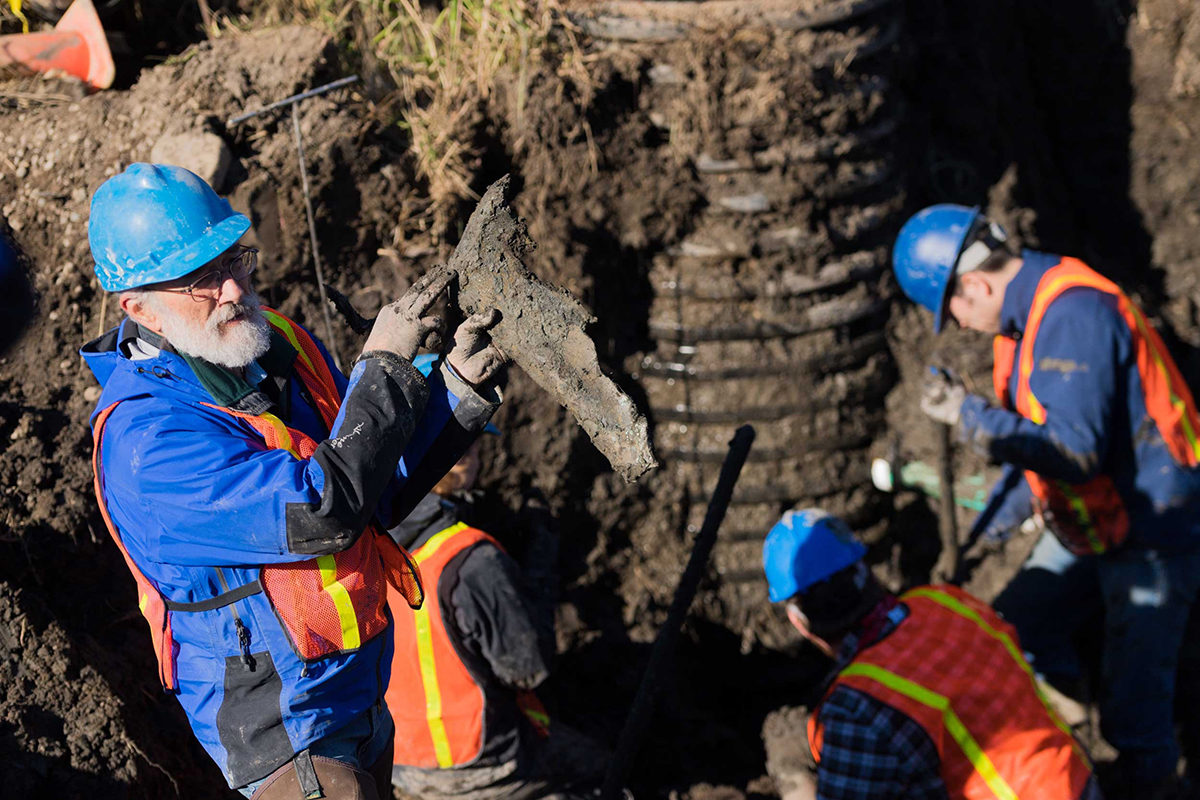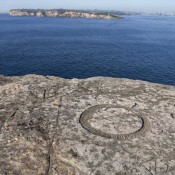University of Michigan paleontologists conducted a second excavation at the Chelsea-area farm where the skull, tusks and dozens of intact bones of an ice age mammoth were pulled from the ground in late 2015.
A U-M news video of the skull and two attached tusks being hoisted from the muddy excavation pit with a backhoe on Oct. 1, 2015, has been viewed more than 875,000 times on YouTube. Nothing that dramatic happened during the two-day follow-up. But 40 additional bones and bone fragments from the Bristle Mammoth were recovered, and the researchers were able to thoroughly document the site. That just wasn’t possible two years ago, in the one-day rush to get the skull and tusks out of the ground.
“This return to the Bristle site was absolutely a success. We got the kind of information that we need to do the science right, and we were also able to recover an impressive amount of additional material from this animal,” said U-M paleontologist Daniel Fisher, who led both Bristle digs and who is overseeing the analysis of the bones and the environmental samples.
“So I’m confident that as a result of this second excavation, we’ll have more insight into what happened here,” said Fisher, director of the U-M Museum of Paleontology.
The first mammoth bones were discovered while Bristle was installing a drainage system at a low spot in one of his fields. The farmer gave U-M researchers one day to recover whatever remains they could find; after that, the drainage project and his harvest for the year needed to resume.
Bristle later donated the mammoth remains to the university, and some of them are now on display at the U-M Museum of Natural History. This week, additional bones were found in clays that were disturbed in 2015 when a sump pump was installed as part of the drainage project. The newly discovered bones will also be donated to the university, Bristle said.
During the first Bristle dig, 55 to 60 nearly complete mammoth bones were found, accounting for 30 to 40 percent of the animal’s skeletal mass. The animal was a male in its mid-40s and would have weighed about 9 tons.
In addition to the skull with teeth and tusks, most of the vertebrae and ribs were found, along with parts of the shoulder blades and the pelvis. Notably missing are the limb and foot bones and the tail vertebrae.
This week, the researchers added 40 more bones and bone fragments, including several vertebrae, skull fragments, an intact rib, part of a shoulder blade, a piece of the pelvis, and what appears to be part of the mandible.
One goal of the second Bristle excavation was to find more bones and, possibly, additional evidence of human involvement. But an even higher priority was to reconstruct the geological context of the mammoth remains, something that simply wasn’t possible during 2015’s get-what-you-can-in-a-day dig.
The Bristle bones were found about 10 feet below the current land surface, in fine-grained clays and marls from the bottom of a pond that no longer exists.
On Tuesday of this week, the researchers dug a pit just south of the October 2015 location and collected sediment samples from the layers exposed in one of the walls. They collected samples at 2-inch intervals, from a couple feet below the top of the pit wall to the gravel at its bottom, a distance of about 13 feet. The gravel at the bottom of the pit is from a time 17,000 to 18,000 years ago, when glacial ice still covered the region, Fisher said.
The oldest well-documented, published evidence for humans in Michigan is about 13,000 years ago, the age of the spear-wielding Clovis hunters. But several lines of evidence from the Bristle Mammoth, including the single radiocarbon date, imply that humans processed the carcass more than 2,000 years before the Clovis hunters arrived.
The Bristle Mammoth remains were found in pond sediments. Fisher suspects early humans butchered the carcass and placed selected portions at the bottom of the pond for storage, using boulders to anchor their meat stash.
Examination of the sediments revealed during this week’s dig suggest the pond was small, perhaps only 20 to 30 yards across, said Fisher, a professor in the Department of Earth and Environmental Sciences and in the Department of Ecology and Evolutionary Biology.




